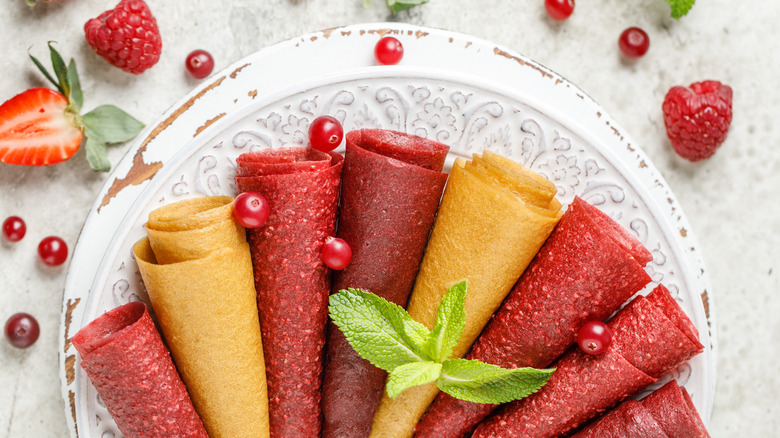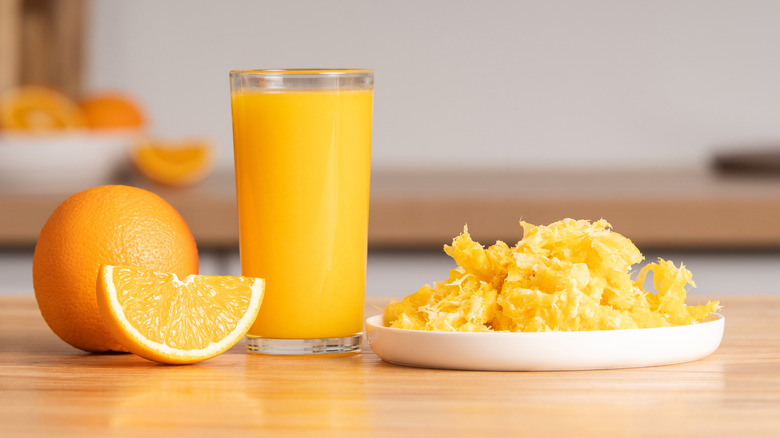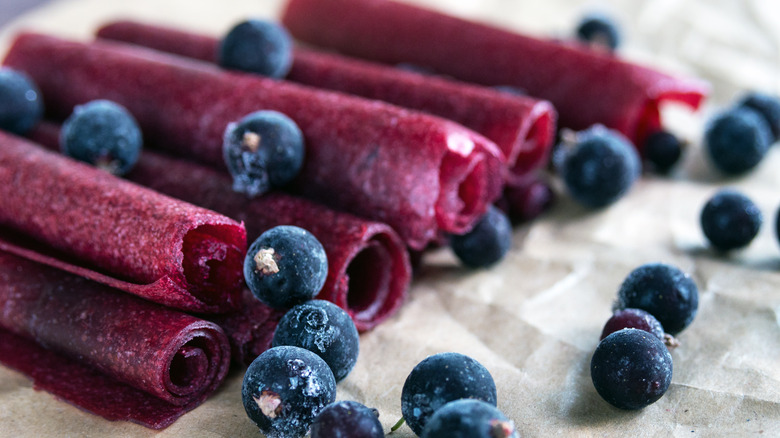Turn Leftover Pulp Into Extra-Flavorful Fruit Leather
There's nothing quite like a fresh-squeezed glass of homemade juice to start your morning right — if only the cleanup wasn't so dreary. One of the most difficult parts of cleaning a juicer is just how much pulp gets left in the machine. While we all know pulp is an inevitable byproduct of fresh juice, simply throwing away all that fruit can feel like a huge waste. Luckily, there's a solution that doesn't involve getting a compost bin: Take all that pulp and turn it into fresh homemade fruit leather.
This creative and eco-friendly approach not only minimizes food waste, but also provides a delicious snack that takes advantage of all the flavor, fiber, and nutrients left behind in pulp. Not to mention, it's an incredibly easy snack that takes little effort to make: All you have to do is get the mixture ready with whatever sweeteners and added ingredients you want, spread it out on a baking sheet, and pop it into the oven until it dries into a chewy and delicious treat.
How to make fruit leather from leftover pulp
Making fruit leather from pulp is easy because most of the work of making fruit leather has already been done for you: The fruit is peeled, mashed up into little pieces, and has had most of its juices already extracted to make for a quicker drying process. How much you even need to prep the pulp before spreading it out to dry depends on the kind of fruit you're using and your personal preferences. However, unless you're using really sweet fruits, you'll usually want to add a little bit of natural sweetener like honey or syrup to the mix. Not only will this sweeten the pulp, but it will help it stick together, yielding a more spreadable consistency. While it might seem counterproductive, you can also add in some water to adjust the viscosity to your liking before pouring it into a lined baking pan.
Once you're done preparing the pulp, line a dehydrator tray or a baking sheet with parchment paper, then pour it onto the paper and spread it evenly, ensuring a consistent thickness. If you have a dehydrator, set it to around 115 degrees Fahrenheit and let the fruit leather sit for approximately 12 to 14 hours. If you're using an oven, crank it to its lowest setting possible, turn on the convection setting if you have it, and check on it frequently as it cooks. The leather should start feeling pliable and chewy in around six to eight hours (depending on your oven temperature and how much moisture is in the mixture), and should be ready in eight to 12 hours, or when it no longer feels sticky.
Additional things to consider when making fruit leather from pulp
The major thing that sets a sheet of fruit leather made from pulp apart from one that was made from canned or fresh fruit is the texture — it'll be more like mottled and mashed pulp instead of the smooth, jelly-like fruit leather you might be more used to. If you're not too keen on this uneven texture, try blending the pulp beforehand. While results may vary depending on the strength of your blender or food processor, this should help you get the fruit leather mixture a little closer to a purée-like consistency.
You should also consider adding some lemon juice to brighten up the flavors, as well as the colors. Additionally, try including fresh herbs and spices to add some complexity to the flavor profile — herbs like mint and basil bring out a refreshing dimension when paired with fruit, while spices like cinnamon and nutmeg add a welcome warmth to any sweet combination. And finally, don't limit yourself to one kind of fruit pulp, but experiment with pulp medleys from different kinds of fruits with different sweeteners, herbs, and spices to make a treat that's not only low-waste, but extra flavorful as well.


